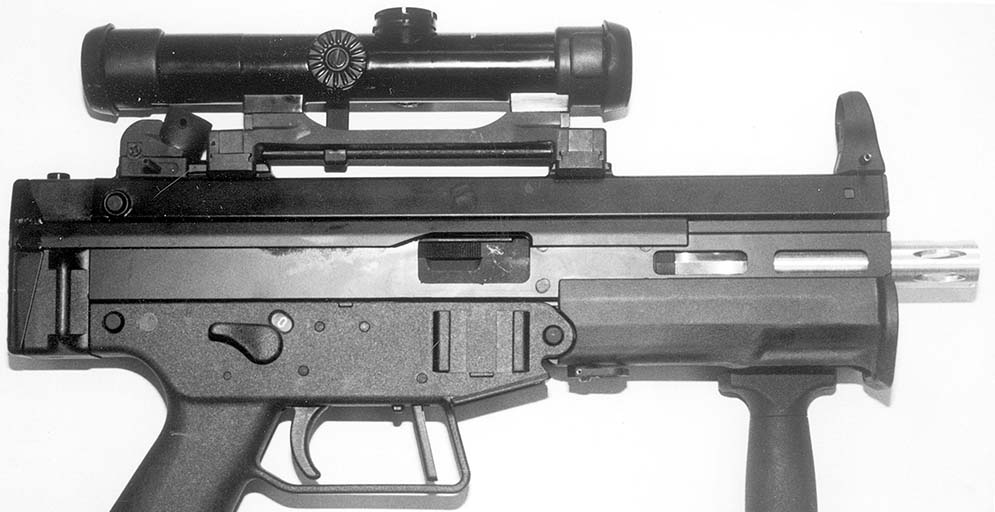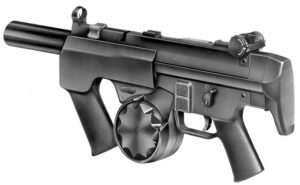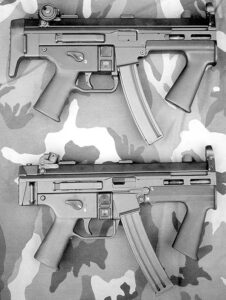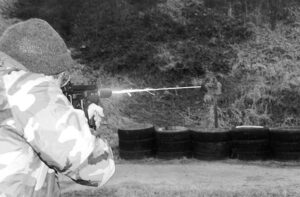A rare photograph of the MP2000. This extremely rare HK sub gun was the missing link between the SMG II in 1984 and the UMP45 of 1997. The MP2000 was developed in 1988-1990 again with the one gun does all concept in mind. The user could fit this modular weapon with adjustable vertical foregrip (3 positions), bolt catch and gas relief valve and even a brass catcher within the bracket shown below the ejection port. The metal receiver MP2000 was dropped in favor of the UMP design with its polymer upper and lower receivers.
By Jim Schatz
In April of 1980 Heckler & Koch responded to solicitation number N00164-80-R-0052 from the Naval Weapons Support Center (NWSC) located in Crane, Indian for the design and fabrication of a Joint Service Submachine, then referred to as the JSSAP Gun. This advanced new 9mm submachine gun was developed for the U.S. Armed Services under the established usr requirements compiled by the Joint Service Small Arms Program (JSSAP) office. The JSSAP gun was intended to bring a modern submachine gun into the ranks of military units, especially those special operations units tasked with close quarters battle in anti-terrorist and hostage rescue missions. Heckler & Koch’s involvement in this program brought about a family of unique submachine guns that would never actually enter series production. However, this does not mean they were not used operationally. A handful of well positioned readers can attest to this fact and many informed experts claim the 9mm submachine gun the Heckler & Koch “SMG” as it would be called, may have been the world’s most flexible smg even today.
Background. An unfilled tactical need arises.
Submachine guns, while used extensively in most of the major conflicts of this century, in many ways were never taken seriously by frontline military personnel. In most cases smg’s like the M3 “Greasegun” and Thompson were utilized as bullet hoses for close range engagements and were often carried by heavy weapon crewmen, unit leaders, armored vehicle personnel, MP’s, etc.- those persons unable or unwilling to carry the full size service rifle of the day. Having said this, the submachine gun has always had its own niche in special “commando” units requiring greater firepower and portability in exchange for reduced combat range.
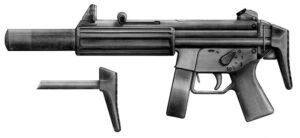
Artists concept of the first HK54A1. Note the distinct similarity to the MP5series. The arrow with dual line marking on the trigger group is the bolt lock position for the safety/selector lever to prevent movement of the bolt during sound suppressed firing. The “50” denotes fully automatic fire from the special 50-round drum magazine envisioned for the weapon.
With the advent of modern terrorism in the 1970’s and the propensity of “T’s” to take hostages in confined spaces like aircraft, buses, ships and buildings the popularity of the submachine rebounded. This is partially due to the sub gun’s quick handling characteristics in tight spaces, diminutive size, reduced range and the hazards to innocents afforded by the pistol caliber cartridges these weapons characteristically fire. The success of the German GSG 9 rescue of hostages held on a Lufthansa airliner in Mogadishu, Somalia in October 1977, and later the highly publicized hostage rescue at the Iranian Embassy in London in May of 1980 by the British SAS put the smg on the map the modern world to see.
The right tool for the job
Any auto mechanic or surgeon knows that it takes more than one instrument to perform a given procedure or operation. This same rule holds true in the world of armed combat. An assault rifle is not always the best weapon for the task at hand, nor is a handgun. In the 1970’s and even today, the inventories of the world’s most elite special units are comprised of a host of small arms that can be drawn from by the operator for the specific mission.
The world-renowned MP5 submachine gun is used by more elite military and police units in the world than any other weapon of its type. By 1980 more than 500,000 MP5’s had already been produced and fielded in countless countries around the world. Units like GSG 9, the British Special Air Service and America’s own Delta Force and SEAL’s teams make all three of the MP5 models available to their shooters for any given mission that may arise. The full size MP5A3 with retractable buttstock and its many variants is the workhorse, responsible for most of the CQB and protection work. However if you’re a climber, swimmer, pilot or the first guy into the breach, you may need one hand free to perform other tasks. In this case the stockless MP5K is a far better choice as it allows for acceptable full auto fire at close ranges with one hand. Although to effectively fire a 4 1/2 pound machine pistol with a cyclic rate of fire of 900 rounds per minutes does require a great deal of practice and acquired skill. For times where the covert engagement of a target is required or where the reduction of muzzle flash in explosive environments is an absolute must, a sound suppressed submachine gun, like the HK MP5SD, is often the first choice. Wouldn’t it be great if all of the capabilities were available in one gun? Enter the SMG.
The JSSAP Gun. Enter the HK54A1
The general concept and goal of the U.S. program was to challenge the industry to create a modular or “family” submachine gun that could be reconfigured by the operator without tools to perform the missions of all three MP5 models described above. Not only would this reduce the sheer number of weapons within a unit but the “one gun does all” concept would insure that the right gun is on station when needed. The level of proficiency can also be elevated to new heights when the shooter need only train with one sub gun and not three. A cost savings? Yes, but in most cases during the past 25 years the cost of equipment and weapons and funding for their procurement was of little or no issue to the elite units of the world. The shooters from the world’s best anti-terrorist and hostage rescue units expend more ammo and ordnance in just one month than the purchase cost of the weapon through which the rounds are fired.
The HK54A1 and the SMG’s that would follow it had to be deployable in all operational and environmental conditions found around the globe. The weapon had to function reliably in temperatures ranging from 140 degrees F to -50 degrees F. The JSSAP Guns were to be carried into combat by swimmers and high altitude parachutists and be fully functional upon arrival. All parts were to be fully interchangeable and supportable by current levels of maintenance. The weapon and sound suppressor were to have a minimal service life of 10,000 rounds, fire in all attitudes (up, down, even sideways) and direct no propellant gas “blowback” into the shooter’s face during operation. In the sound suppressed mode it should be impossible to discern the visual “flash” and the report or mechanical noise of the weapon beyond 30 meters and provide at least 30 dB sound reduction when fired in the sound suppressed mode. The HK54A1 was to be accurate enough to allow first round hits on an E-type kneeling silhouette target at 100 meters with iron sights.
Using their protocol for assigning acronyms internally, HK calls the MP5 the HK54 (5 for submachine gun, 4 for caliber 9X19mm Luger) even today some 35 years after the first gun rolled out of the stamping presses in Oberndorf. The MP5 designation was one assigned by the German government when it adopted the weapon for governmental use. The A1 suffix denotes the modifications incorporated into the basic HK54 to meet the technical and performance requirements of the JSSAP solicitation. For about $180,000 of Uncle Sam’s money, HK designed and produced fully tested hand-built HK54A1 prototypes to prove the concept of the JSSAP Gun. Actually HK spent a great deal of its own IR&D funds on the initial design and testing of the HK54A1 prior to the release of the competitive JSSAP solicitation in 1980.
The HK54A1 pictured herein looks very much like the MP5SD we know today. In an attempt to use available production tooling and MP5 parts the “A1” was essentially a product-improved MP5 and little more. It was certainly a gun far too large and cumbersome to be used in the one handed role of the MP5K. The weapon was a delayed blowback operated submachine gun using HK’s famous roller locking system chambered for the widely available 9X19mm Luger cartridge. (It is interesting to note in HK’s proposal to the USG that it was mentioned that “the HK54A1 could be converted to caliber .45 ACP if required”). The 7-pound weapon with retractable buttstock included an integral sound suppressor, a 3-round burst mode, which can be fired at a sustained rate of 1,000 rounds per minute. Unique features of the HK54A1 included the means for the operator to selectively vent propellant gases from the ported barrel in order to reduce the velocity of supersonic ammunition below the subsonic threshold (1,088 fps at sea level) and for suppressed fire without the need for special subsonic ammunition not always available “away from home”. The HK54A1 could utilize a 30-round stick magazine but was also designed to use low profile 50-round drum magazines for increased “firepower”. A forward assist for silent loading, a bolt catch to hold the bolt open on the last round fired, an ambidextrous magazine release lever in the trigger guard, an ambidextrous safety/selector lever and sling mounting points made the weapon usable for left and right handed shooters.
A unique bolt lock positioned on the trigger group beyond the sustained fire position locked the bolt in a forward position to prevent movement of the bolt and thus offered the user nearly silent operation. The A1 had adjustable tritium sights and a hinged trigger guard to allow firing while wearing heavy cold weather or diving gloves. Complete specifications of the HK54A1 are included in the Comparison Table accompanying this article.
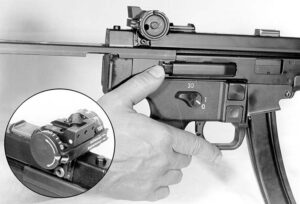
The “silent bolt closing mechanism”, or forward assist if you will. To avoid the noise caused by releasing the bolt during loading the forward assist can be used to fully chamber the round with minimal noise and 100 % assuredness that the bolt is fully forward and the weapon ready to fire. Inset: The overly complex rear sight assembly of the SMG. The right drum was used for course elevation adjustment and had positions for both subsonic and supersonic ammunition out to 150 meters. Many expensive target rifles would be envious of this sight! The weapon is SMG serial number 011 from November 1983.
With all of it’s unique features, the HK54A1 was still produced mainly from stamped, folded and welded sheet steel like most HK’s of the day. While not perfect for the intended roles of the JSSAP Gun the HK54A1 met most of the operational requirements listed above and thus caught the attention of the U.S. Government. This successful demonstration of the weapon’s performance and HK’s abilities to meet difficult technical challenges led to a fully funded R&D program for the “SMG” in 1983 after a second proposal was submitted to the NWSC Crane in February.
SMG
While there were various models of the first SMG prototype with different features, the basic SMG was a 9mm weapon with semi and fully automatic modes of fire, a removable retractable buttstock and a threaded barrel for a removable sound suppressor. Without the buttstock the SMG was less than 14 inches in overall length and weighed 6.70 pounds unloaded without a magazine. This placed the SMG only slightly closer to the size and weight of the stockless MP5K (at 12.8 inches long and 4.40 pounds) than the full size MP5A3. Thus the goal of building a one-gun-does-all modular “family” submachine gun was at least partially achieved with the basic layout of the new SMG design.
Like the HK54A1 that came before it, the SMG was produced mainly from sheet metal components except the pistol grip and vertical foregrip. The weapon fired from a closed bolt but unlocked breech, a departure from the delayed blowback roller-locked bolt of the MP5 and HK54A1 that came before it. A notable departure for HK was the use of a simple blowback operation in the SMG. This was an attempt to reduce the complexity and cost of the weapon. The SMG was comprised of a lower receiver and a separate upper receiver with a user removable barrel. Using a simple barrel wrench to unscrew the locking nut this fundamental change represented an important departure for an HK long gun where barrels were usually pressed and pinned in place and considered a factory job to remove or replace.
A combination mechanical (spring) and hydraulic buffer reside in the removable backplate and, along with a “timing device” incorporated in the trigger group, help reduce the rate of fire of the SMG to a more manageable 500 rounds per minute – one half that of the HK54A1 “bullet hose”. The rectangular one-piece machined metal bolt assembly contains an inertia firing pin which can be disassembled for cleaning as well as a firing pin safety to prevent the firing pin from reaching the chambered round during rough handling or drops. A fixed but oversized trigger guard provides ample room for gloved fingers and the trigger can accommodate an add-on winter trigger for times where mittens are preferred over gloves.
The curved double column magazine for the SMG is produced from folded sheet metal and provides a capacity of 30 rounds. Ambidextrous operating controls abound on the SMG. The unique centrally located cocking handle, similar in design and location as that found on the Thompson or UZI submachine guns, reciprocates with the bolt and could be used to lock the bolt open or to release the open bolt by simply rotating the cocking handle 90 degrees. Two adjacent square buttons, located rearward of the magazine well on the plastic pistol grip, act as ambidextrous bolt catch release (top) and magazine release (bottom). The texturing of the two buttons is different to provide the user with a tactile feel to differentiate between the two controls during “blind” actuation of these buttons. These controls are very well positioned on the weapon allowing actuation with the non-firing thumb or firing index finger without wasted motion of the hands.
The ambidextrous combined safety/selector lever is typical of the HK MP5 but is positioned for easy reach and rotation into the firing modes without having to adjust the firing grip. A forward assist for silent loading (without letting the bolt slam forward) is provided on the SMG on the receiver above the right side safety/selector lever. The sliding buttstock with a hard plastic contoured buttplate can be retracted, extended or completely removed from the receiver simply by depressing a round button protruding behind the rear sight assembly. Ambidextrous sling attachment points for the typical and much copied HK multi-purpose combat carrying sling are provided on both sides of the receiver.
The sights of the SMG are extremely interesting if not overly complicated for a pistol caliber submachine gun. While weapon number 006 pictured in this article does not contain a gas relief valve for reducing the velocity of supersonic ammunition to subsonic levels, the weapon is set up to utilize both types of ammunition. The front sight is the stereotypical HK round hood with a fixed tritium dot front sight post inside.
The rear sight is in itself a technical marvel. A single peep aperture positioned on an elevating ladder is flanked by a pair of “Betalite” (tritium) capsules providing the user with an effective “3-dot” arrangement. The rear sight is sandwiched between two drums, obviously inspired by the design of the HK21E machine gun rear sight. The drum to the left is used to make course windage adjustments and requires no tools to do so. The right drum is actually two concentric drums, one inside the other. The outer drum is pushed inward onto a caming surface calibrated for the flight profile of supersonic 124-grain NATO ball ammunition. When the outer drum is pulled to the right, a different caming surface within the sight assembly adjusts the height of the rear sight for the different trajectory of subsonic ammunition. The elevation drum is marked for ranges from 25 to 150 meters and even has an “M” position that grossly elevates the rear sight aperture by nearly one full inch. In this position the line of sight is raised for firing the weapon wearing a gas mask, protective equipment which prevents the shooter from establishing a normal and proper cheekweld on the forks of the buttstock. (Note: When using the M setting the range is established for 25 yards and closer. The top of the front sight hood serves as a rough front sight “post”). Both rear sight drums provide tactile indents to allow the user to “find” the 25-meter setting without the need to look at the sight. The rear sight can also be battlesight zeroed using nothing more than a Phillips head screwdriver. As if the SMG’s iron sight arrangement was not enough, the weapon also incorporates two welded scope mounting platforms that allow a scope or reflex sight to be quickly attached to the weapon by means of an HK scope mount shorter than but similar to that used on the HK21E and MSG90 sniper rifle.
The sound suppressor for the SMG actually has two different designs. Both are sealed units with metal baffles of “wipeless” design. Both suppressors encompass the barrel via a tubular extension and are secured to the weapon via the threads located around the base of the short 5.8-inch barrel. An aluminum sound suppressor from HK, basically a variation of the MP5SD suppressor, was developed for the SMG as was a far heavier stainless steel sound suppressor employing more advanced-machined steel baffles designed by Mickey Finn.
Numerous samples of the SMG were delivered to the Naval Weapons Support Center in Crane Indiana in 1984 for complete and extensive testing. Though minor problems were encountered, the overall performance of the SMG was very good indeed. It was the conclusion of the final test report that with minor changes prior to production, the SMG would serve well the special operators in the U.S. who needed the capability of three submachine guns in one tactically flexible weapon. HK was informed of the desired changes and shortcomings of the SMG and was asked to produce additional test samples for further testing. In 1985 HK delivered the new and improved SMG II to Crane.
SMG II. Twice as good?
Thinking back to the original design goal of the JSSAP Gun described earlier in this article, the SMG and to a greater extent the HK54A1 did not fully meet these requirements. Clearly, as is the case with most new hardware developments – cars, VCR’s and computers – it simply takes repeated design, prototype fabrication, testing, rework and retesting to optimize a mechanical device such as a firearm from prototype to finished product. The SMG II incorporated all of the ideas, changes and corrections deemed necessary by the testers and actual users involved in the JSSAP program testing. The SMG II became the modular one-gun-does-all submachine gun for which the program set out to obtain.
With the SMG II, the basic model with a retractable buttstock and without a sound suppressor is a 14-inch long weapon – a full 7 inches shorter than the MP5A3. By simply adding a sound suppressor to the basic weapon, the operator could create an “MP5SD” from the same platform. For missions where a small one-handed “MP5K” was required, the sound suppressor and buttstock were removed and the “telephone booth clearing” full auto SMG II “pistol” was created by the operator in the field or in route to the target.
The SMG II being based on the SMG was very similar in operation and design though there were a number of important changes and additions. To reduce the weight and production cost of the weapon, the magazine, backplate and entire lower receiver were produced from plastic. The 3-round burst mode of the HK54A1 had returned in the SMG II, as did the gas relief valve. Located on the receiver just forward of the flared magazine well this lever had two positions, “L” for low and “H” for high. Pulling out the front captured locking pin and sliding the plastic vertical foregrip forward off of the receiver revealed a small gas cylinder mounted parallel with and under the barrel that resembles the CO2 cartridges commonly used in airguns. When the gas relief valve was set in the “L” position a port opened in the barrel that allowed a measured amount of propellant gases to escape into this “holding tank”. By diverting this gas away from behind the projectile in the bore the exit velocity of the projectile is effectively lowered. A supersonic ball round fired in the SMG II with the gas port open departed the weapon below the speed of sound and thus eliminated the telltale “crack” of a supersonic projectile. Once the projectile left the bore in route to the target the gas remaining within the cylinder exits from the muzzle.
When the gas relief valve is placed in the “H” position the gas port is closed and all available gas is used to propel the projectile to the target at full velocity. This setting was used when firing subsonic ammo, when the sound suppressor was not being used or where the maximum terminal energy of the projectile on target was the primary concern of the user. Thus, unlike the MP5SD and HK54A1, the SMG II could be fired with or without the sound suppressor attached and used effectively with supersonic or subsonic ammunition with just the flick of a switch. It is interesting to point out at this point that the bolt lock feature of the HK54A1 was dropped from both of the SMG models because it did not reduce the sound signature of the weapon beyond a level provided by the sound suppressor. In other words beyond 30 meters the mechanical noise of the bolt was less than the noise of the departing projectile and escaping residual gases. Eliminating this feature lessened the complexity of the weapon and thus its cost. It also insured the user always had an immediate second shot available should the first round fired with the bolt lock engaged not perform as intended on its target.
One of the more noticeable changes from the SMG to the SMG II was the rear sight. Gone was the over-engineered and unnecessarily complicated rear sight. In its place the HK designers mounted the proven MP5 diopter rear sight assembly but added two tritium dots to the ears of the rear sight base for low light use in conjunction with the front tritium sight. While functional many American shooters found the sight line too low to use comfortably, unable to push the face far enough down on the stock to properly align the sights.
A spring détente was added to the receiver to prevent the sound suppressor from turning loose during firing and the three locking pins in the SMG II were retained in much the same way as the captured receiver pins of the U.S. M16 rifle to prevent loss. Other than minor changes made to facilitate production and durability, the SMG and SMG II were for the most part identical.
A better mousetrap? So where are the guns?
There were less than 20 SMG’s and 20 SMG II’s made in the 1980’s as part of the JSSAP program, each one basically a handmade prototype. At the conclusion of all this testing, the potential users, especially the Navy Special Warfare community, had already acquired a quantity of MP5’s after being introduced to the merits of the gun by foreign users such as the SAS and GSG 9. When it was time to ante up and procure sub guns, most users opted to stay with and purchase additional MP5’s rather than the SMG II. It was in 1986 that HK developed the “Navy” specific or “N” model MP5-N, MP5SD-N and MP5K-N for the Navy SEAL and SDV teams and Special Boat Units. Navy model MP5’s and variations of the basic MP5 were adopted by most of this nation’s military and law enforcement special units. The combination of little or no interest in a submachine gun for conventional military units and a less than enthusiastic demand from the spec ops community for the SMG II meant the gun was destined to go nowhere fast. Or did it?
A particular American organization, which will remain nameless, saw the tactical advantage of the one-gun-does-all concept that the SMG II offered, approached HK about building sixty SMG II’s for operational deployment. It did not appear that the gun would enter a series production so sixty SMG II’s were fabricated by HK as handmade prototypes at a unit cost of @ $2,800 each. Up until two years ago, these weapons were still in operational use and well liked by the shooters. However the chronic lack of availability of spare parts for the guns and the move to 5.56mm weapons for the CQB role, which was once the exclusive domain of the submachine gun, forced the weapons into mothballs and ultimately into the smelter.
Shooting the SMG
The accuracy of the SMG is on par with that of the basic MP5. The controllability of the MP5 in bursts longer than 3 rounds is hard to beat. Though the standard vertical foregrip of the SMG helps control the weapon in sustained fire, the delayed blowback roller-locked bolt system employed in the MP5 is believed by many to help reduce the felt recoil of the weapon and thus make it easier to control the weapon in long bursts. This may be true to an extent but one would also have to consider the longer length of the MP5, its barrel and sight radius as features that make the MP5 simply “feel” more controllable to fire in the sustained fire mode. The fact is when timed and firing short bursts, the results on the target – round placement and group size – between the roller-locked MP5 and the simple blowback operated weapons like the SMG are generally indistinguishable. The rate reduction system in the SMG II which reduces the cyclic rate of fire to @ 500 rounds per minute certainly aids in the weapon’s sustained fire control.
Firing the weapon in the fully automatic mode of fire with one hand, like the MP5K or any machine pistol for that matter, is difficult and down right ineffective as far as hits are concerned beyond engagement ranges of 20 yards or more. However, it is the range band from one side of an airliner or bus to the other wherein the MP5K model or stockless SMG II would reign supreme.
The well-designed and positioned operating controls of the SMG II are a plus to ease and speed reloads. The low sight line of the SMG II makes it all but impossible to fire the weapon using the iron sights. Using the optical sight on the HK QD mount solves that problem. Firing the weapon suppressed, especially left handed, is somewhat disconcerting due to the amount of gas blowback from the ejection port. The use of goggles eliminates this as a concern however. Reliability, as in all HK’s, is excellent.
Nothing ventured nothing gained
While HK’s hopes to get the SMG type-classified in the U.S. military and produced at their new Chantilly Virginia production site all but evaporated at the close of the JSSAP program in the mid-1980’s, the money spent by HK and the lessons learned were not in vain. In the late 1980’s HK had continued work on the “family” sub gun concept to the point where the SMG II’s successor, and the new UMP’s predecessor, entered the test lab at HK’s factory in Oberndorf, Germany. The MP2000 took the concept of modularity and lightweight materials to the next level for a submachine gun. Though only a few were built as prototypes for internal testing, the 9mm MP2000 had all of the features and capabilities of the SMG and SMG II, and more. The 5-pound MP2000 included the bolt lock like that of the HK54A1 and gas relief valve similar in concept to that of the SMG II and was modular allowing the gun to be “built up” by the user for the specific task at hand. After a great deal of extensive testing at HK the MP2000 was also dropped from further consideration as a series production gun though the U.S. Navy did order ten MP2000’s for testing for possible use by their SEAL teams. This purchase order was never filled.
In 1998 HK announced the debut of the new UMP45 submachine gun. It was a distant relative of the MP5 with all the influence from experience, testing, design and production know-how of the prototype guns that appeared before the UMP, including the HK54A1, SMG, SMG II and MP2000. While no longer envisioned as a one-gun-does-everything concept, the new HK Universal Machine Pistol does make use of polymer materials in most components of the weapon, weighs only 4.5 pounds unloaded and is available in the more potent calibers of .45 ACP and .40 S&W.
A family of submachine guns seldom seen by more than just a few fortunate individuals and true operators, today the SMG remains HK’s most successful failure.
| This article first appeared in Small Arms Review V4N6 (March 2001) |



